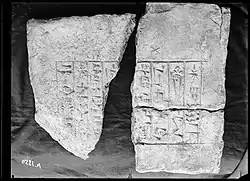Ili-Ishar
Ili-Ishar, also Ilum-Ishar (𒀭𒄿𒊬, Il3-Ishar), was a ruler of the city of Mari, northern Mesopotamia, after the fall of the Akkadian Empire c. 2084-2072 BCE.[2] His father was Apil-Kin (𒀀𒉈𒆠𒅔), and his brother was Tura-Dagan, who succeeded him.[3]
| Ili-Ishar | |
|---|---|
| Military governor of Mari | |
 Brick with inscription of "Ili-Ishar, Shakkanakku of Mari", commemorating a canal-building project.[1] | |
| Reign | c.2100 BCE |
| Predecessor | Iddi-ilum |
| Successor | Tura-Dagan (brother) |
| Dynasty | Shakkanakku dynasty |

He held the title of Shakkanakku (military governor), which was borne by all the princes of a dynasty who reigned at Mari in the late third millennium and early second millennium BC. These kings were the descendants of the military governors appointed by the kings of Akkad.[4] He was contemporary of the Third Dynasty of Ur, and probably their vassal.[5]
He was contemporary of the Third Dynasty of Ur, and probably their vassal.[6]
Several brick inscriptions in the name of Ili-Ishar have been found in Mari, describing the building of a canal:
"Ilum-išar, šakkanakku of Mari, made the Ḫubur go down to Bāb-Mēr"
On some of his inscriptions, Ili-Ishar uses the title dannum' ("the Great") in front of his function Shakkanakku ("Military Governor"), a practice which is first attested at Mari from the inscriptions of Apil-Kin, and was initially introduced by Naram-Sin of the Akkadian Empire.[9]
 Inscription "Ili-Ishar Shakkanakku Mari-ki" (𒀭𒄿𒊬 𒄊𒀴 𒈠𒌷𒆠, "Ili-Ishar, Military Governor of Mari") on the brick
Inscription "Ili-Ishar Shakkanakku Mari-ki" (𒀭𒄿𒊬 𒄊𒀴 𒈠𒌷𒆠, "Ili-Ishar, Military Governor of Mari") on the brick Inscriptions of Ilum-Ishar, excavated in Mari
Inscriptions of Ilum-Ishar, excavated in Mari
Ili-Ishar of Mari | ||
| Regnal titles | ||
|---|---|---|
| Preceded by Iddi-ilum |
Shakkanakku of Mari c.2084-2072 BCE |
Succeeded by Tura-Dagan |
References
- Leick, Gwendolyn (2002). Who's Who in the Ancient Near East. Routledge. p. 94. ISBN 978-1-134-78795-1.
- Leick, Gwendolyn (2002). Who's Who in the Ancient Near East. Routledge. p. 78. ISBN 978-1-134-78795-1.
- Leick, Gwendolyn (2002). Who's Who in the Ancient Near East. Routledge. p. 168. ISBN 978-1-134-78796-8.
- Louvre. "The Statuette of Iddi-Ilum," Department of Near Eastern Antiquities: Mesopotamia. Accessed December 1, 2014. http://www.louvre.fr/en/oeuvre-notices/statuette-iddi-ilum
- Unger, Merrill F. (2014). Israel and the Aramaeans of Damascus: A Study in Archaeological Illumination of Bible History. Wipf and Stock Publishers. p. 5. ISBN 978-1-62564-606-4.
- Unger, Merrill F. (2014). Israel and the Aramaeans of Damascus: A Study in Archaeological Illumination of Bible History. Wipf and Stock Publishers. p. 5. ISBN 978-1-62564-606-4.
- Loisel, Anne-Caroline Rendu. "Ilum-Isar et Apil-Kin, deux nouvelles inscriptions de Mari/Tell Hariri". In L. Feliu / J. Llop / A. Millet Alba / J. Sanmartin (Ed), Time and History in the Ancient Near East, Proceedings of Rencontre Assyriologique Internationale 56, Barcelone, Juillet 2010, Pp.633-643.
- THUREAU-DANGIN, F. (1936). "TEXTES DE MÂRI". Revue d'Assyriologie et d'archéologie orientale. 33 (4): 177–179. ISSN 0373-6032. JSTOR 23284100.
- Loisel, Anne-Caroline Rendu. "Ilum-Isar et Apil-Kin, deux nouvelles inscriptions de Mari/Tell Hariri". In L. Feliu / J. Llop / A. Millet Alba / J. Sanmartin (Ed), Time and History in the Ancient Near East, Proceedings of Rencontre Assyriologique Internationale 56, Barcelone, Juillet 2010, Pp.633-643: 649.